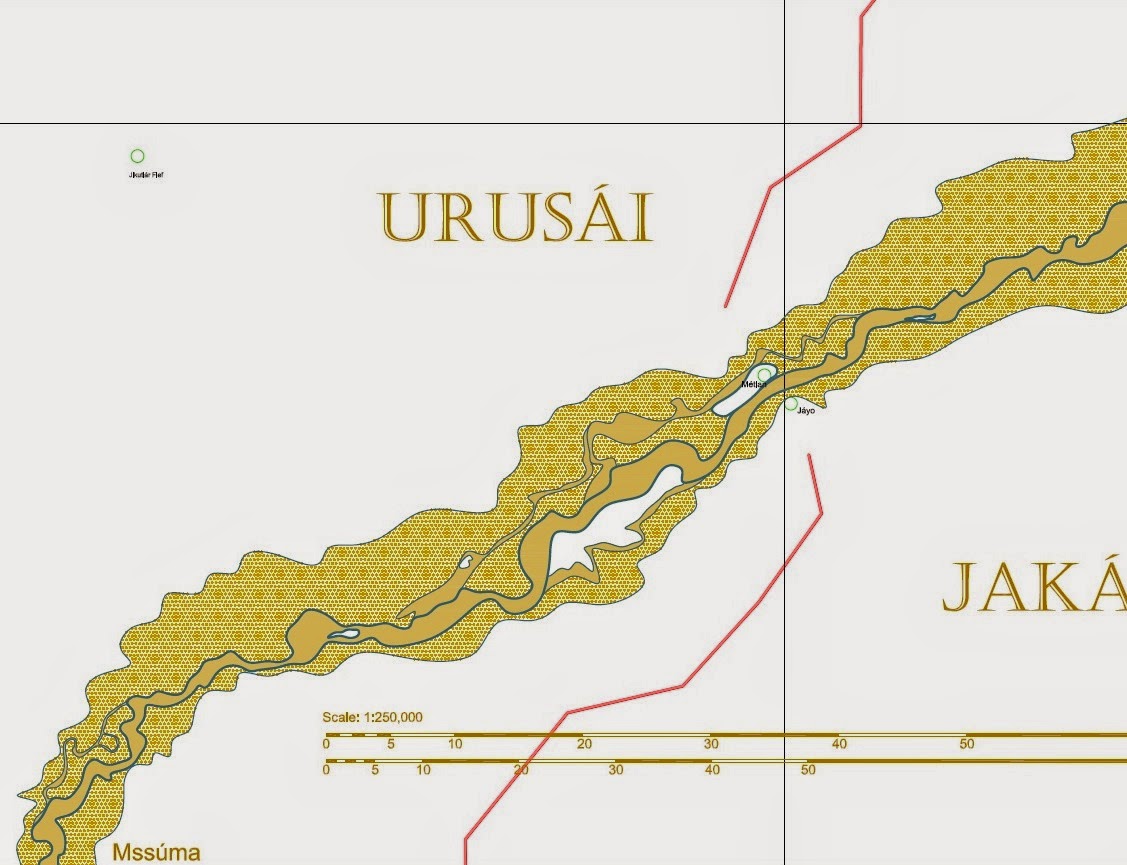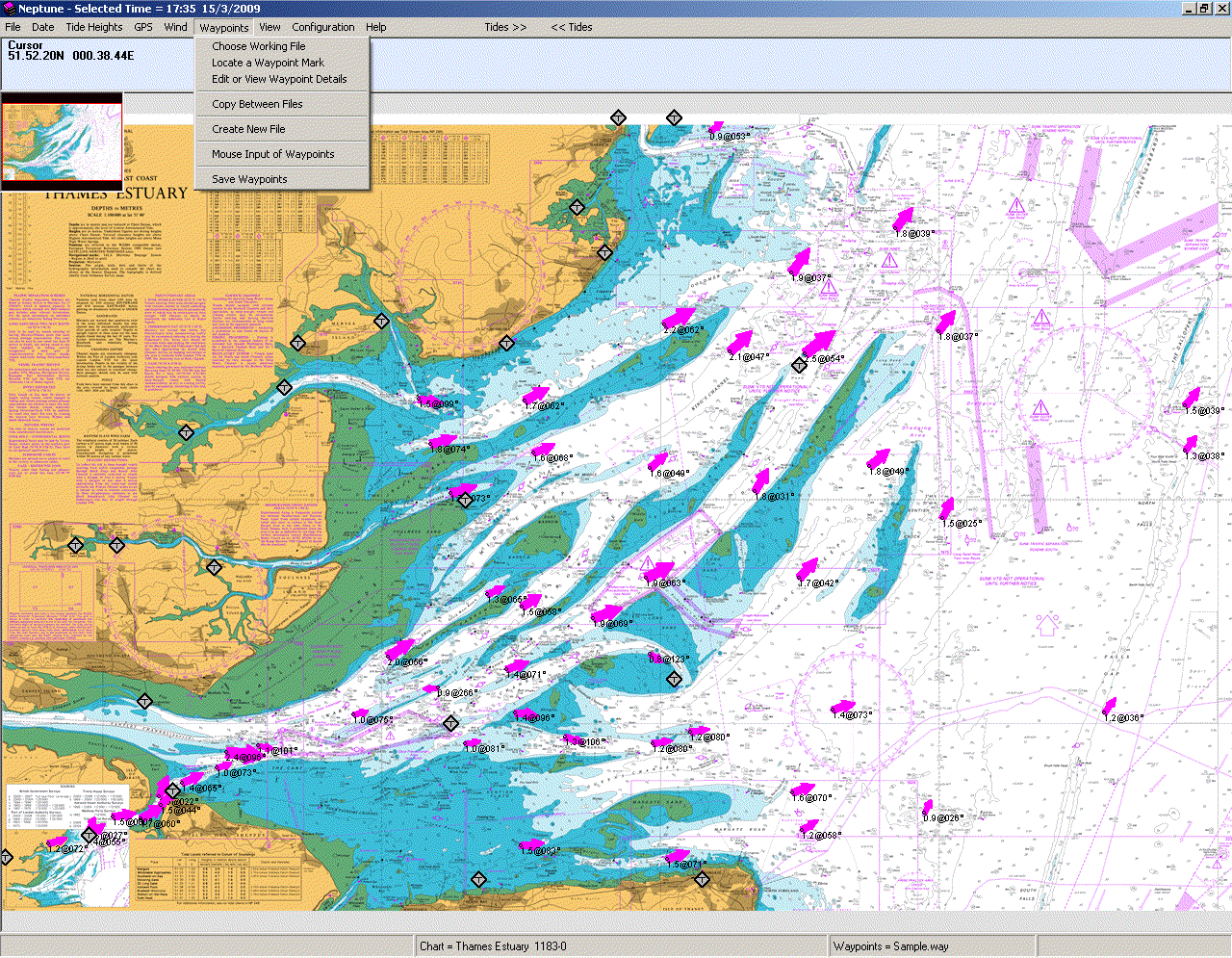The Mssúma River Delta
Moving on from yesterday's post, here is the Mssúma river delta - still only roughly blocked in. You will notice that I have decided to show the Mssúma in a sandy-yellow rather than the blue normally used for water. It seemed fitting considering that is closer to the colour!
Shown is the "main channel" - keeping in mind that this is changeable over time. Also shown are some secondary channels, also changeable. These are channels that might go dry in the summer but are open for much of the rest of the year. The lighter toned areas represent an approximation of the flood plain. They are just blocked in at the moment and will no doubt be modified. What I did initially was just trace the outer edge of the river as drawn on the Swords and Glory map. When scaled that feature became quite wide. The problem is that is too consistent a width which is a problem especially the closer to the source you get. A more realistic floodplain would, IMO, be narrower closer to the source and have more wider expanses - the river would of course inundate any low-lying areas. I just have to add some more in to make it look less regular.
This drawing also shows the village of Nisuel (lower left), Chokuga village and Jikutlar fief (top). These feature in one of the solo Adventures on Tékumel books.
Another view, showing the shallow lakes I've added...
These lakes, at lower left, are those mentioned in my U Bien Bridge post a few days ago. That line just to the right of them is part of a polygon I drew to attempt to enclose the Mssúma River watershed, which in turn allowed me to estimate its area. The horizontal wavy line is the approximate boundary of the Flats of Tsechélnu. My assumption is that during flood season the river inundates large areas...
Also note that I've been making up names again: Urúra, a village or town near by those lakes.
Moving up river...
Where the sákbe road meets the river I have chosen to place two small towns; in my campaign they are called Métlan and Jáyo. They are meant to be the Tsolyáni equivalent of Buda and Pest. :-)
The outer edges of the so-called floodplain really need to be worked on. I have to add some minor rivers and streams. In the real world I think there would be hundreds of them! Note again the secondary channels that dry up during the hot summer. Note also that there are two that I have drawn distinct from each other. That is because I think they would become dry at different times, the shallower channel drying first.
By a coincidence I was watching BBC World News or Al Jazeera (I think - I suppose it might have been a North American station but I somehow doubt it) earlier this year and they were interviewing the peasant farmers in Pakistan displaced by the flooding. Apparently the government wants to permanently resettle these people but they don't want to leave, despite being routinely displaced. The reason they don't want to leave is that the flooding deposits so much rich sediment that the crops grow really well. Their whole lifestyle is built around temporary homes and the difference this year is just that the flooding was more extensive.
I think the Mssúma river farmers would be much the same. Their main crops would be grown in the flood plain where the soil is rich. Their main clan houses would be near by the edge of the floodplain or on higher areas within it. If necessary they would build more temporary residences within the plain, possibly on stilts. When the floods come they would move to the main clan houses, and as the waters recede they would move back and plant their crops for the new growing season.
Mssúra
This map moves up river a bit, again showing the main and secondary channels and a roughly blocked in flood plain. Also shown is the village of Mssúra, another of my made up places. My assumption is that the Mssúma river valley is densely populated - perhaps the most densely populated area in Tsolyánu - so there should be lots of towns and villages all along its length.
Usenánu
What's this? Two additional rivers?!!
Moving north again we come to the city/town/village of Usenánu. I have always thought of it as a city but in the Deeds of the Ever-Glorious it is referred to as a village. Of course, the scribe who wrote that passage might have been writing it at a time when Usenánu was indeed only a village!
The problem is that one expects to have everything set out in stone for the game. The Professor, however, presented his work as actual historical documents so there are bound to be contradictions, or seeming contradictions. Of course, this isn't actually a problem at all; by doing it this way each game master can tailor the world to suit his needs. And it adds an awesome amount of flavour! :-)
At Usenánu the "village/city" thing isn't the only seeming contradiction I encountered. To the best of my knowledge, descriptive references are few and far between. There is the above mentioned reference in the description of the legion raised there, but the only other reference I know about is the text description in the "Growing up on Tékumel" booklet. This is the little booklet that details character generation. In it the male character example is from Usenánu and he provides a short description of the place, giving some names for the main streets and plazas and that sort of thing.
He mentions the sákbe road heading off to the west but fails to mention that it crosses a river even though, based upon the location of the symbol on the map, it should cross the river coming south from Háuma. He does mention docks and - IIRC - a ferry to the east. And he names that river as the Umétla river whereas the Gardasiyal map calls it the Arjáshtra!
So the initial problem is are we referring to the same river with two different names? Not without real world precedence; the Ganges seems to have many names along its length. Or are there two rivers?
My solution is to assume the latter. I assume that the river that flows south from Háuma is the Arjáshtra river, but as it gets wider - and perhaps there are sometimes two channels that entwine about each other - the name Umétla comes into the picture. This name, occurring further south, is given to the wider channel whereas the narrower one retains the name Arjáshtra. Just north of Usenánu the two diverge and the smaller Arjáshtra continues almost directly south while the wider Umétla flows more to the south-east. At this point the Arjáshtra channel is so insignificant that in the high summer it might completely dry up, so it is no wonder that it does not receive a mention.
On the map shown above I've used the Pála Jakálla city map as a sort of placeholder. I've only tried a rough pencil sketch of the place itself. I don't recall the population range given via the key on the Swords and Glory map. That is, I suppose the next step. I've tried to make the local topography interesting. I assume that the area with the Mssúma river label is prone to flooding which is why the sákbe road does that hook to the north. I also assume that there are ferries across both the Mssúma and Umétla rivers.














































